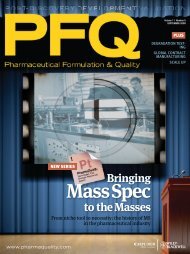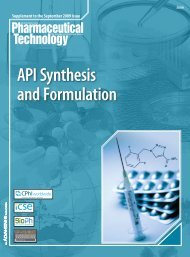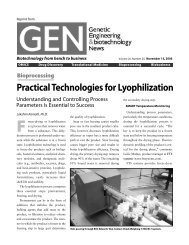High-Temperature Stability | Do the Math for Shelf Life - Sterile ...
High-Temperature Stability | Do the Math for Shelf Life - Sterile ...
High-Temperature Stability | Do the Math for Shelf Life - Sterile ...
- No tags were found...
You also want an ePaper? Increase the reach of your titles
YUMPU automatically turns print PDFs into web optimized ePapers that Google loves.
QUALITY CONTROL | HIGH-TEMPERATURE STABILITYTable 3.Months at 25degrees C toreach 1.0% w/wdegradant limit(kinetic shelf life)241812claim/month) and 10% drug loss at threemonths at 40 degrees C (k40 = —3.3333 drug%label claim/month), <strong>the</strong> calculated Ea is 26kcal/mole. For <strong>the</strong> model that assumes 10%drug loss at 24 months at 25 degrees C (k25 =—0.4167 drug %label claim/month) and 10%drug loss at six months at 40 degrees C (k40= —1.6667 drug %label claim/month), <strong>the</strong>calculated Ea is 17 kcal/mole.Knowledge of <strong>the</strong> Ea is key to <strong>the</strong> interpretationof accelerated data <strong>for</strong> predictionsat lower temperatures. If <strong>the</strong> Ea islow (less than or equal to 17 kcal/mole), <strong>the</strong>accelerated 40 degrees C drug concentrationmust remain greater than 90% labelclaim <strong>for</strong> six months to achieve at least90% label claim <strong>for</strong> a shelf life of 24Table 4.Months at 25degrees C toreach 1.0% w/wdegradant limit(kinetic shelf life)2418129Relationship of rates and activation energy (Ea) <strong>for</strong> shelf-lifestability when limit is reached after six months at 40 degrees C.k25 (%w/w permonth) Rate ofdegradant growth at25 degrees Cthrough shelf life0.04170.05560.0834k40 (%w/w permonth) Rate ofdegradant growth at40 degrees C when1.0% w/w limit isreached at sixmonths0.16670.16670.1667Ea (kcal/mole)activation energy1714month at 25 degrees C. If <strong>the</strong> Ea is high(more than or equal to 26 kcal/mole), <strong>the</strong>accelerated 40 degrees C drug concentrationmust remain greater than 90% labelclaim <strong>for</strong> only three months (and be 80%label claim at six months), and yet <strong>the</strong>product will remain at or above 90% labelclaim <strong>for</strong> a shelf life of 24 month at 25 degreesC. This application of Ea and Arrheniuskinetics to predict shelf life can beapplied to any drug level (limit) specified.Theoretical Model <strong>for</strong>Impurity/Degradant GenerationThe same approach can be used to understandand predict <strong>the</strong> generation of impurities/degradants.For this exercise, aRelationship of rates and activation energy (Ea) <strong>for</strong> shelf-lifestability when limit is reached after three months at 40 degrees C.k25 (%w/w permonth) Rate ofdegradant growth at25 degrees Cthrough shelf life0.04170.05560.08340.1111k40 (%w/w permonth) Rate ofdegradant growth at40 degrees C when1.0% w/w limit isreached at threemonths0.33330.33330.33330.33339Ea (kcal/mole)activation energy26221714zero-order degradation kinetics model(ΔImpurity/Δtime = —k) is applied to determine<strong>the</strong> rates <strong>for</strong> an arbitrary 1% impuritygrowth at 25 degrees C and at 40degrees C. The calculated slope <strong>for</strong> growthfrom 0 to 1.0% w/w over 24 months at 25degrees C is equal to 0.0417% w/w permonth, which is <strong>the</strong> impurity generationrate constant at 25 degrees C (k25). In <strong>the</strong>same manner, <strong>the</strong> impurity generationrate at 40 degrees C can be calculated <strong>for</strong>reaching 1.0% w/w after three months(0.3333% w/w per month) and <strong>for</strong> reaching1.0% w/w after six months storage (0.1667%w/w per month). Table 2 summarizes <strong>the</strong>corresponding rates and Eas:Example calculationWhere:Ln k 2 /k 1 = -Ea/R*(1/T 2 -1/T 1 ) (Equation 3)Ln (k40/k25) = - [Ea/1.987*(1/313-1/298)]/1000cal/kcalk40 = 0.1667%w/w degradant/monthk25 = 0.0417%w/w degradant/monthSolving <strong>for</strong> Ea:Ea = - [Ln (0.1667/0.0417)*1.987]/[(1/313-1/298)*1000]Ea = 17 kcal/moleAs <strong>the</strong> Ea increases, <strong>the</strong> reaction rateat 40 degrees C increases. The degradantlevel at six months at 40 degrees C is predictiveof <strong>the</strong> degradant level to be reachedafter 24 months at 25 degrees C when <strong>the</strong> Eais 17 kcal/mole. Degradants with reactionmechanisms with high activation energies(greater than 17 kcal/mole) can exhibitlevels exceeding 1.0% w/w by six monthsat 40 degrees C, yet have 25 degrees C valuesbelow <strong>the</strong> 1.0% w/w limit.<strong>Shelf</strong> <strong>Life</strong>, Rates, andActivation EnergyTo demonstrate <strong>the</strong> importance of Ea inpredicting long-term shelf life at 25 degreesC from 40 degrees C rates, <strong>the</strong> Arrheniuskinetic equation was used to demonstrate<strong>the</strong> relationship of reaction rates and Ea. Therelationships are demonstrated in Table 3<strong>for</strong> <strong>the</strong> scenario where <strong>the</strong> degradantreaches <strong>the</strong> 1.0% w/w limit at six monthsat 40 degrees C and <strong>the</strong> zero-order rateconstant (k40) is equal to 0.1667% w/wdegradant/month.Table 4 demonstrates <strong>the</strong>se relationships<strong>for</strong> <strong>the</strong> scenario where <strong>the</strong> degradantreaches <strong>the</strong> 1.0% w/w limit at three monthsat 40 degrees C and <strong>the</strong> zero-order rateconstant (k40) is equal to 0.3333% w/wPharmaceutical Formulation & Quality > April/May 2011






